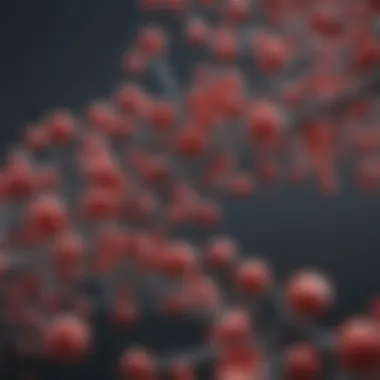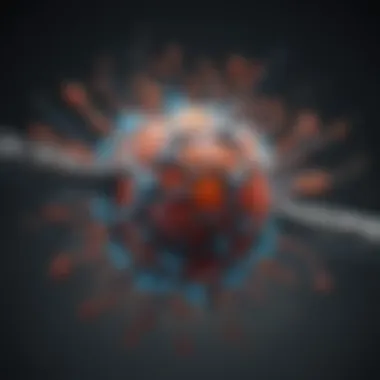Interleukin 1 Receptor Antagonist: Mechanisms and Applications


Intro
The interleukin 1 receptor antagonist (IL-1ra) is a naturally occurring protein that has significant implications in the realm of immunology. Its primary function is to inhibit the activity of interleukin 1 (IL-1), a key cytokine that plays a crucial role in promoting inflammation and immune responses. Understanding the biochemical pathways and mechanisms of IL-1ra provides insight into its potential therapeutic applications, particularly in managing various inflammatory diseases.
This article provides a thorough overview of IL-1ra, examining its mechanisms and clinical applications. Through this exploration, we aim to illustrate the relevance of IL-1ra in health and its potential for therapeutic strategies aimed at mitigating inflammation and associated tissue damage.
Research Overview
Summary of Key Findings
Recent studies have underscored the importance of IL-1ra in regulating inflammatory processes. Key findings highlight the following points:
- IL-1ra effectively modulates the immune response by blocking IL-1 signaling.
- Elevated levels of IL-1ra have been observed in conditions such as rheumatoid arthritis and sepsis, indicating its role in pathological inflammation.
- Therapeutic use of IL-1ra demonstrates benefits in clinical settings, particularly in reducing inflammation and promoting healing.
Research Objectives and Hypotheses
The objective of this research is to elucidate the mechanisms by which IL-1ra operates within the inflammatory processes and to assess its clinical utility in various inflammatory ailments. The primary hypotheses guiding this investigation include:
- Mechanistic understanding: Investigating the biochemical pathways that govern IL-1ra's effectiveness in inflammatory response modulation.
- Clinical applications: Assessing the therapeutic potential of IL-1ra in managing inflammatory diseases, thereby reducing morbidity and enhancing quality of life.
Methodology
Study Design and Approach
The research employs a multi-faceted approach, integrating both in vitro and in vivo methodologies to provide a comprehensive analysis. The design encompasses experimental models that simulate inflammatory conditions, allowing for closer observation of IL-1ra's effect on immune responses.
Data Collection Techniques
Data collection techniques include assays to measure cytokine levels, flow cytometry for immune cell profiling, and histological analysis to assess tissue inflammation. These methods ensure a robust and thorough examination of IL-1ra’s properties and applications.
In closing, the investigation of interleukin 1 receptor antagonist reveals its pivotal position in managing inflammatory pathways. The upcoming sections of this article will dive deeper into its mechanisms and examine the clinical implications of IL-1ra in diverse medical contexts.
Preface to Interleukin Receptor Antagonist
The interleukin 1 receptor antagonist (IL-1ra) serves as a pivotal element in the understanding of immunology and inflammation. Its role in the body is particularly crucial for balancing the immune responses and ensuring that inflammation does not result in excessive tissue damage. As a natural cytokine inhibitor, IL-1ra acts by blocking the actions of interleukin 1 (IL-1), which is a significant pro-inflammatory cytokine involved in a variety of immune responses.
Definition and Significance
Interleukin 1 receptor antagonist is a protein that is crucial in regulating inflammatory processes. It functions by binding to the interleukin 1 receptor, thus preventing IL-1 from exerting its pro-inflammatory effects. The significance of IL-1ra lies in its ability to modulate the immune system, making it an essential player in various inflammatory conditions. The presence of IL-1ra helps to bring a balance to the immune system. Without it, the unchecked action of IL-1 could lead to severe inflammatory responses, contributing to chronic diseases.
Furthermore, IL-1ra is not just a passive participant; it actively participates in various therapeutic approaches. Its understanding has implications not only for researchers but for clinical practitioners aiming to optimize treatments for inflammatory diseases.


Historical Background
The exploration of interleukin 1 receptor antagonist can be traced back to the late 1980s when researchers first identified it as a naturally occurring protein. Initial studies focused on its structure and function, revealing its ability to inhibit IL-1. Over time, further investigations uncovered IL-1ra's potential in clinical settings, particularly in conditions characterized by excessive inflammation.
The development of IL-1ra as a therapeutic agent has evolved considerably since its discovery. Early applications included its use in rheumatoid arthritis, where it demonstrated significant effects in managing disease symptoms. As research continued to unfold, the spectrum of its utility expanded, recognizing its importance in a wider variety of chronic inflammatory and autoimmune disorders. This historical progression underlines how increasing knowledge on IL-1ra contributes to enhanced strategies in treating complex diseases.
Biochemistry of Interleukin Receptor Antagonist
The biochemistry of interleukin 1 receptor antagonist (IL-1ra) is crucial for understanding its function and therapeutic potential in inflammatory diseases. This section addresses the structural and functional aspects, delving into what makes IL-1ra a significant entity in modulation of immune responses. By exploring the intricate details of its structure, how it operates biochemically, and how it compares to interleukin 1, one can grasp why IL-1ra is a key player in managing inflammation.
Structure and Composition
Interleukin 1 receptor antagonist is a protein that belongs to the interleukin 1 family. Its molecular weight is approximately 17 kDa. The structure is composed of 153 amino acids with a unique arrangement that allows it to effectively block the interleukin 1 receptor. The three-dimensional conformation of IL-1ra closely resembles that of interleukin 1 alpha, enabling it to bind to the receptor yet without activating it. This ability is a cornerstone of its function as an antagonist. Understanding its structure helps researchers design better therapeutic agents and strategies.
Mechanism of Action
The mechanism of action of IL-1ra is quite direct. It competes with IL-1 for binding to the interleukin 1 receptor. When IL-1ra occupies the receptor, it prevents IL-1 from exerting its inflammatory effects. This blockade is critical during inflammatory responses as IL-1 is known to promote the production of additional pro-inflammatory cytokines and chemokines.
Moreover, IL-1ra can modulate T-cell activation and polarization, further influencing the immune response. Targeting this pathway, therefore, becomes an attractive opportunity for therapeutic interventions in diseases characterized by unwanted inflammation.
Comparison with Interleukin
When comparing IL-1ra to interleukin 1, several key differences emerge. IL-1 is primarily pro-inflammatory, facilitating cell signaling pathways that lead to inflammation and tissue damage. In contrast, IL-1ra acts as a natural inhibitor. The balance between these two proteins is vital for maintaining homeostasis within the immune system.
In summary, understanding the biochemistry of IL-1ra, including its structure, mechanism, and comparison with IL-1, lays a foundation for appreciating its clinical significance. As research grows, these insights can potentially lead to innovative treatments for chronic inflammatory diseases.
Role of Interleukin Receptor Antagonist in Inflammation
The interleukin 1 receptor antagonist (IL-1ra) is fundamental in inflammation modulation. Understanding its role offers insight into how it helps to balance immune reactions, preventing excessive damage to tissues. Inflammation is a vital response to injury or infection, but when uncontrolled, it can lead to a range of chronic conditions. This necessitates regulatory mechanisms, with IL-1ra being a significant player.
Regulation of Immune Responses
Interleukin 1 receptor antagonist plays a crucial role in regulating immune responses. IL-1ra binds to IL-1 receptors but does not activate them, effectively blocking the pro-inflammatory signals that interleukin 1 would normally propagate. This inhibition is essential in maintaining homeostasis. It ensures that the immune response does not become overly aggressive, which is vital for tissue repair and recovery. When IL-1ra levels are adequate, the immune system functions effectively without causing additional harm. In certain cases, low levels of IL-1ra can lead to unchecked inflammation, exacerbating conditions such as rheumatoid arthritis or inflammatory bowel disease.
Impact on Cytokine Production
Cytokines are signaling molecules that mediate and regulate immunity and inflammation. The presence of IL-1ra influences the production of various cytokines. It helps to decrease the levels of pro-inflammatory cytokines, like TNF-alpha and IL-6. By doing so, IL-1ra alters the cytokine profile in the microenvironment, promoting an anti-inflammatory state. This influence is particularly significant during acute inflammation, where appropriate resolution is necessary to prevent chronicity. In this context, understanding IL-1ra's role opens avenues for therapeutic interventions aimed at enhancing its effects, thus mitigating the risks associated with dysregulated inflammatory responses.
Role in Chronic Inflammatory Diseases
The implications of interleukin 1 receptor antagonist extend to chronic inflammatory diseases. Conditions such as type 2 diabetes, atherosclerosis, and even neurological disorders have shown associations with elevated IL-1 levels. In these situations, IL-1ra offers a protective mechanism against the consequences of sustained inflammation. Research indicates that IL-1ra administration may alleviate symptoms and improve outcomes in patients with chronic inflammatory conditions. By targeting the balance of IL-1 and IL-1ra, newer treatment strategies can potentially emerge, offering relief to those suffering from these debilitating diseases. The ongoing exploration of IL-1ra in the context of chronic illness highlights its relevance in therapeutic contexts beyond what was traditionally understood.
Clinical Applications of Interleukin Receptor Antagonist


The clinical applications of interleukin 1 receptor antagonist (IL-1ra) showcase its potential in treating various inflammatory conditions. Understanding how IL-1ra impacts health can lead to more effective therapeutic strategies. Its role in reducing inflammation is beneficial in many clinical settings. This section examines specific therapeutic uses, its contribution to autoimmune diseases, and its impact on metabolic disorders.
Therapeutic Uses
IL-1ra is primarily known for its ability to block the action of interleukin 1, a potent pro-inflammatory cytokine. This blocking can lead to several therapeutic benefits:
- Reduction of Inflammation: In conditions where inflammation is excessive, IL-1ra helps restore balance by inhibiting the effects of IL-1.
- Pain Management: By alleviating inflammation, IL-1ra can indirectly reduce pain levels associated with inflammatory diseases.
- Enhanced Recovery: Inflammatory responses can delay healing. IL-1ra helps in quicker recovery from tissue damage by modulating inflammation.
Research has shown positive outcomes in various conditions, including osteoarthritis and rheumatoid arthritis, where IL-1ra administration has improved patient outcomes.
IL-1ra in Autoimmune Diseases
Autoimmune diseases, characterized by an inappropriate immune response towards bodily tissues, can benefit significantly from IL-1ra treatment. The therapeutic potential of IL-1ra is evident in several autoimmune conditions:
- Rheumatoid Arthritis: IL-1ra shows promise in reducing inflammatory markers and slowing disease progression.
- Type 1 Diabetes: Studies suggest that IL-1ra can help preserve beta-cell function in early stages of the disease.
- Multiple Sclerosis: The anti-inflammatory properties of IL-1ra may provide therapeutic effects in mitigating disease flares.
Using IL-1ra in combination with other immunotherapies may also enhance treatment efficacy, although further research is needed to standardize these approaches.
Role in Metabolic Disorders
Recent investigations have unveiled IL-1ra's role in metabolic disorders. Chronic low-grade inflammation can lead to metabolic disturbances. IL-1ra appears to be a key factor in addressing this inflammation:
- Obesity: Elevated IL-1ra levels have been associated with obesity, suggesting a potential regulatory role in inflammatory processes that contribute to obesity-related complications.
- Type 2 Diabetes: Chronic inflammation is a well-known contributor to insulin resistance. IL-1ra may improve insulin sensitivity by mitigating inflammatory responses.
"The involvement of IL-1ra in metabolic disorders illustrates its wider implications beyond classical inflammatory diseases."
This ability to influence metabolic health suggests that IL-1ra is not only relevant for immune modulation but also essential for maintaining metabolic balance.
Research Developments in IL-1ra
Research surrounding Interleukin 1 receptor antagonist (IL-1ra) has gained momentum recently. This section explores significant findings and outlines future directions for investigation. These developments underline the critical importance of IL-1ra in various inflammatory conditions, impacting therapeutic strategies and patient outcomes.
Recent Findings
Recent studies have significantly advanced our understanding of IL-1ra's role in inflammatory processes. For instance, researchers have discovered that IL-1ra's expression levels correlate with disease severity in conditions like rheumatoid arthritis and inflammatory bowel disease. This correlation suggests that monitoring IL-1ra levels could provide insights into disease progression and treatment response.
- A notable study published in Nature Reviews Immunology reported that IL-1ra can decrease the secretion of pro-inflammatory cytokines in tissue models. This finding supports the therapeutic use of IL-1ra in managing excessive inflammatory responses.
- Another research focused on the role of IL-1ra in chronic pain associated with autoimmune conditions. The results indicated that IL-1ra not only reduces inflammation but also modulates pain pathways, offering potential for developing pain management therapies.
These findings reflect a broader emphasis on understanding IL-1ra in the context of not only inflammation but also its auxiliary effects on pain and immune modulation.
Future Directions in Research


As research into IL-1ra continues, several future directions emerge. These areas can enhance understanding and broaden therapeutic applications.
- Genetic Studies: Investigating the genetic regulation of IL-1ra expression could yield insights into individual susceptibility to inflammatory diseases. Identifying genetic polymorphisms associated with IL-1ra could aid in personalized medicine approaches.
- Combination Therapies: Exploring the synergistic effects of IL-1ra with other treatments may enhance its clinical efficacy. Combining IL-1ra with biologics that target different inflammatory pathways could lead to improved outcomes in patients who do not respond to monotherapies.
- Long-term Effects: Future studies should focus on the long-term effects of IL-1ra therapy in chronic conditions. Understanding the implications of prolonged use can help clinicians make informed decisions regarding treatment plans.
Research in these areas will provide deeper insights into IL-1ra and its relevance in various diseases, culminating in improved therapeutic strategies.
"The ongoing research developments in IL-1ra signify not just scientific advancements but also the potential for revolutionizing treatment protocols for inflammatory diseases."
Challenges and Limitations
The exploration of interleukin 1 receptor antagonist (IL-1ra) underscores its potential for therapeutic innovation. However, it is crucial to acknowledge that there are challenges and limitations in its application. Understanding these barriers is essential for optimizing treatment strategies, especially in complex inflammatory conditions. This section delves into the significant hurdles posed by potential side effects and therapeutic resistance when using IL-1ra in clinical settings.
Potential Side Effects
Although IL-1ra is vital in regulating inflammatory responses, it may cause some side effects that are important to consider. The suppression of IL-1 activity can lead to unintended consequences in immune function. Some reported side effects include:
- Increased susceptibility to infections: By inhibiting IL-1, the body may struggle to respond effectively to pathogens, raising the risk of infections.
- Potential for allergic reactions: Some patients may experience hypersensitivity to IL-1ra, leading to skin rashes or other allergic manifestations.
- Altered metabolic responses: There can be metabolic changes associated with prolonged use of IL-1ra that might affect weight or overall health.
Monitoring patients for these side effects is essential. Clinicians must balance the benefits of reducing inflammation with these potential risks to ensure patient safety and treatment efficacy.
Therapeutic Resistance
Therapeutic resistance is another significant challenge when utilizing IL-1ra. Over time, some patients may exhibit diminished responsiveness to the treatment, complicating long-term management of inflammatory diseases. Factors that contribute to therapeutic resistance include:
- Genetic variations: Individual differences in genetic makeup can affect how IL-1ra functions, leading to variability in patient responses.
- Disease complexity: Chronic inflammatory diseases often involve multiple pathways and mediators. When these pathways adapt, they may bypass the effects of IL-1ra, thereby diminishing its effectiveness.
- Development of neutralizing antibodies: In some cases, the immune system may produce antibodies against IL-1ra, reducing its biological activity and causing a therapeutic failure.
Addressing therapeutic resistance requires ongoing research and careful patient management. It is critical to tailor treatments to individual patient profiles, employing combination therapies when necessary to enhance the overall efficacy of IL-1ra.
As the field evolves, understanding these challenges will lead to more effective use of IL-1ra in treating inflammatory diseases.
In summary, while IL-1ra presents remarkable potential, the challenges it faces, including potential side effects and therapeutic resistance, necessitate careful consideration in clinical practice. Only through a thorough understanding of these factors can we harness IL-1ra's full therapeutic potential.
Ending
The conclusion of this article serves as a pivotal juncture, synthesizing the comprehensive insights gathered regarding the interleukin 1 receptor antagonist (IL-1ra). Understanding IL-1ra is essential for grasping its multifaceted role in inflammatory responses. It outlines how this cytokine inhibitor is not just a passive agent but a critical player in the complex interactions that influence immune regulation and tissue health.
Summary of Key Points
The key points of this article can be summarized as follows:
- Definition and Role: IL-1ra is a crucial natural antagonist that modulates the effects of interleukin-1, thereby controlling inflammation.
- Biochemistry: The unique structure and mechanism of action of IL-1ra underscore its significance in preventing excessive inflammatory responses.
- Clinical Applications: The therapeutic uses extend beyond autoimmunity, influencing a wide range of inflammatory diseases and conditions.
- Research Developments: Recent studies shed light on the evolving understanding of IL-1ra’s role, encouraging ongoing investigation.
- Challenges: Awareness of potential side effects and therapeutic resistance remains critical in translating research findings into clinical practice.
Implications for Future Research
Research into IL-1ra holds considerable promise, but it also faces challenges. Future investigations must focus on:
- Mechanistic Studies: Understanding the specific molecular pathways through which IL-1ra mediates its effects could lead to improved therapeutic strategies.
- Broader Applications: Expanding research on its role in diverse diseases such as diabetes and cardiovascular disorders could unveil new treatment avenues.
- Safety Profiles: Comprehensive evaluations of side effects will ensure safer clinical applications in various patient populations.
"The interleukin 1 receptor antagonist could be a key player in targeted therapies for chronic inflammatory diseases."















